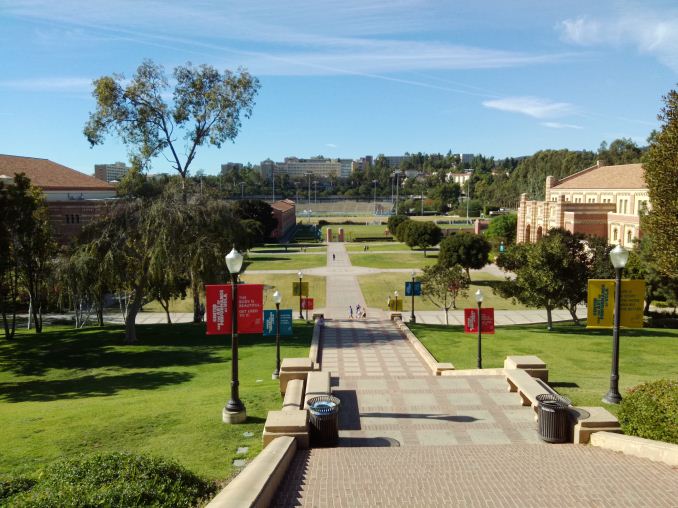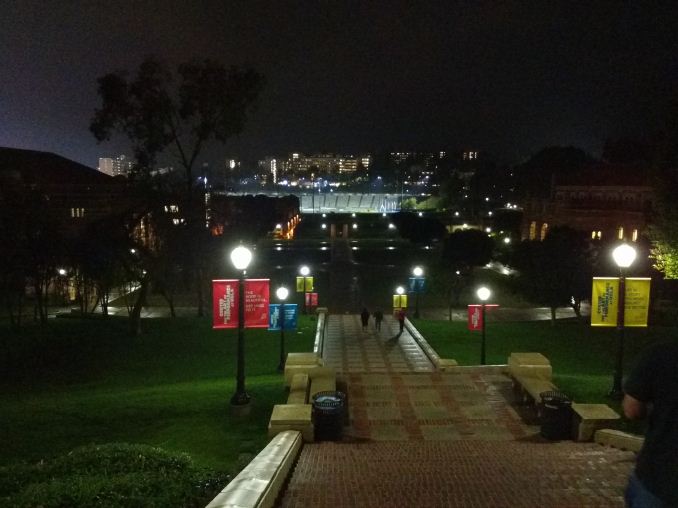The Google Nexus 9 Review
by Joshua Ho & Ryan Smith on February 4, 2015 8:00 AM EST- Posted in
- Tablets
- HTC
- Project Denver
- Android
- Mobile
- NVIDIA
- Nexus 9
- Lollipop
- Android 5.0
Camera
In the case of tablets, cameras have become increasingly important. While it’s still a bit awkware to take photos and video with a tablet, there is still value to having decent cameras on a tablet. For the front-facing camera, it’s pretty clear that there is a lot of value to be had here as the tablet can be a good tool for video conferencing in lieu of a bulky laptop. The rear camera can also have value, but mostly for taking a photo of a whiteboard or simply when opportunity dictates. To fulfill these duties, the Nexus 9 has been outfitted with a rather standard set of cameras. On the rear, we see an 8MP, 1/4 inch format sensor while the front-facing camera has a 1.6MP, 1/5 inch sensor. I’ve included a table of the full camera specs below in the interest of readability.
| Camera Specifications | |||
| Google Nexus 9 | |||
| Front Camera | 1.6MP | ||
| Front Camera - Sensor | OV9760 (1.75µm, 1/5") |
||
| Front Camera - Focal Length | 2.18mm | ||
| Front Camera - Max Aperture | F/2.18 | ||
| Rear Camera - Sensor | IMX219 (1.12 µm, 1/4") |
||
| Rear Camera - Focal Length | 3.097mm (33mm eff) | ||
| Rear Camera - Max Aperture | F/2.4 | ||
This is pretty much par for the course when it comes to tablets. The optics aren’t particularly remarkable in one way or another, as I haven’t noticed any obvious design issues in any of my test photos, and the focal length isn’t excessively long or short. The UI that comes with Google Camera in general is unremarkable as well. This isn’t a slight against it, but the fact that I don’t have anything significant to complain about is a good step forward from the past when the design of the camera UI was a significant friction point in the user experience.
The one issue that I’ve noticed is that the camera’s auto focus and capture speed are significantly worse than what I saw on the iPad Air 2. Unfortunately, it isn’t really possible to have standardized testing here as a tablet can’t be mounted to a tripod for testing. As there isn’t a custom ISP in the Nexus 9, it’s likely that the Tegra ISP isn’t up to scratch here as I noticed that AF speed is similar to what I saw on the SHIELD Tablet despite differing camera modules.
For the most part, there’s not much else to be said about the camera systems on the Nexus 9 as they aren’t quite as heavily focused as one would see in the smartphone space. All that’s left to do is test the cameras themselves.
In this basic test of daytime photo quality, we can see that HTC has done a reasonably good job of processing the image as noise is generally suppressed without an enormous loss of detail. However, there really isn't a lot of detail to speak of in this sensor. There's also a decent amount of dynamic range as there's detail in the shadows but there's no HDR mode to compensate in cases where there is insufficient dynamic range. HTC continues to cap the base ISO to 100, which seems to be a strange move in this situation as the shutter speed is more than high enough to drive the sensor gain even lower.
In this low light scenario, the Nexus 9 effectively falls flat on its face. With an ISO of 3200 and a shutter speed of 1/12s, there's effectively no detail past the first set of steps. Luminance noise is strong and present throughout the image, and color noise also has a tendency to creep in as well. Given the sheer size of the tablet, it's also hard to stably hold the tablet to take a photo despite the relatively fast 1/12s shutter speed. One should really avoid using this to take photos in low light unless there's no other choice.
In video, detail generally tends to be about the same as what one can find in photos, which means that daytime footage should have decent quality but low light rapidly reduces the quality as the sensor gain must increase. In the case of the Nexus 9, we see that video tops out at 1080p30 maximum with no slow motion available, and that the file is in a .3gp format instead of a standard mp4 that most are familiar with. The video itself is encoded with H.264 baseline at 14 Mbps, which is likely to be below the maximum that the encoder can support. There doesn't appear to be any significant level of stabilization in this case, which is a bit disappointing although not entirely surprising. There is also a lot of focus hunting throughout the video, which is quite distracting.
Overall, it seems that the camera on the Nexus 9 is an acceptable one for a tablet, although this would effectively be unacceptable on a high-end smartphone. The camera itself produces decent output in daytime but really suffers in low light due to the small pixel size, relatively narrow aperture, and small sensor. There are also a lot of issues with consistent and reliable auto focus, as it often takes multiple focus runs to get the camera to focus properly on even high contrast objects. Each focus run takes a significant amount of time as well, which hurts the shooting experience when combined with the somewhat long capture latency. I would avoid using this camera unless it is strictly necessary, although it isn't terrible as a camera for cases such as document scanning.
























169 Comments
View All Comments
PC Perv - Wednesday, February 4, 2015 - link
It is clear, even though you did not say, why no one other than NV and Google will use Denver in their products. Thank you for the coherent review, Ryan.P.S. I can't wait for the day SunSpider, Basemark, and WebXPRT disappear from your benchmark suit.
jjj - Wednesday, February 4, 2015 - link
You always make those kind of claims about dual core vs more cores but you have never attempted to back them up with real world perf and power testing.In real use there are alerts and chats and maybe music playing and so on. While your hypothesis could be valid or partially valid you absolutely need to first verify it before heavily insisting on it and accepting it as true. Subjective conclusions are just not your style is it, you test things to get to objective results.
And it wold be easy you already have "clean"numbers and you would just need to run the same benchmarks for perf and power with some simulated background activity to be able to compare the differences in gains/loses.
PC Perv - Wednesday, February 4, 2015 - link
Where would you put the performance of "backup" ARM-only part of Denver? Cortex-A7? Is it measurable at all?Also, why don't Samsung use F2FS for their devices? I thought it was developed by them.
abufrejoval - Wednesday, February 4, 2015 - link
While the principal designer seems to be a Korean, I'm not sure he works for Samsung, who typically used Yet Another Flash File System (YAFFS).Ryan Smith - Wednesday, February 4, 2015 - link
It's not measurable in a traditional sense, as the DCO will kick in at some point. However I'd say it's somewhere along the lines of A53, though overall a bit better.Shadowmaster625 - Wednesday, February 4, 2015 - link
The design philosophy of the DCO does make a lot of sense. When your mobile device starts to bog down and you start cursing at it, what is it usually doing? It is usually looping or iterating through something. The DCO wont help with small blocks of code that execute in 500uS, but you dont need help with that sort of code anyway. What you want to improve is exactly the type of code the DCO can improve: the kind of code that takes several dozen milliseconds (or more) to execute. That is when you begin to notice the lag in your cpu.mpokwsths - Wednesday, February 4, 2015 - link
Joshua & Ryan,please update the charts with the bench results of the newer version of Androbench 4: https://play.google.com/store/apps/details?id=com....
(I had previously commented on the fact that you can't safely compare the i/o results of different OS AND different bench apps).
Androbench 4 is redesigned it to use multiple i/o threads (as a proper i/o bench app should have) and produces vastly improved results on both Lollipop and earlier Android devices.
You will not be able to compare the newer results with older ones, but at least it will put an end to this ridiculus ι/ο performance difference between iOS and Android, the one you persistently -but falsly- keep projecting.
Andrei Frumusanu - Wednesday, February 4, 2015 - link
I tested this out on several of my devices and could see only minor improvements, all within 10%. The performance difference to iOS devices does not seem to be a dupe at all.mpokwsths - Wednesday, February 4, 2015 - link
My results strongly disagree with you:Nexus 5: Seq Write: 19MB/s --> 55 MB/s
Rand Write: 0.9 --> 2.9 MB/s
Sony Z3 Tablet: Seq Write: 21 MB/s --> 53 MB/s
Rand Write: 1,6 MB/s --> 8MB/s
Seq Read: 135 MB/s --> 200MB/s
I can upload pics showing my findings.
mpokwsths - Wednesday, February 4, 2015 - link
Meet the fastest Nexus 5 in the world:https://www.dropbox.com/s/zkhn073xy8l28ry/Screensh...;)